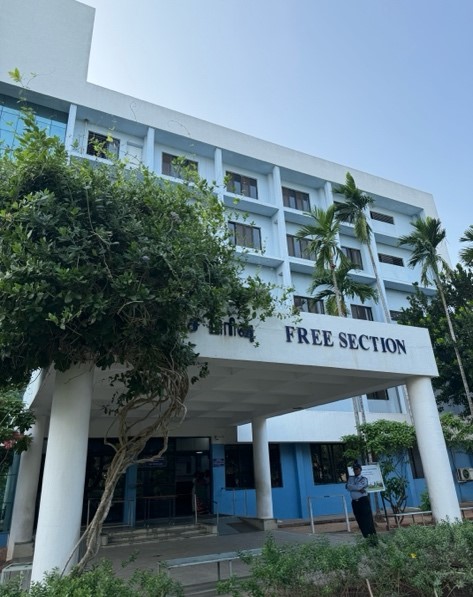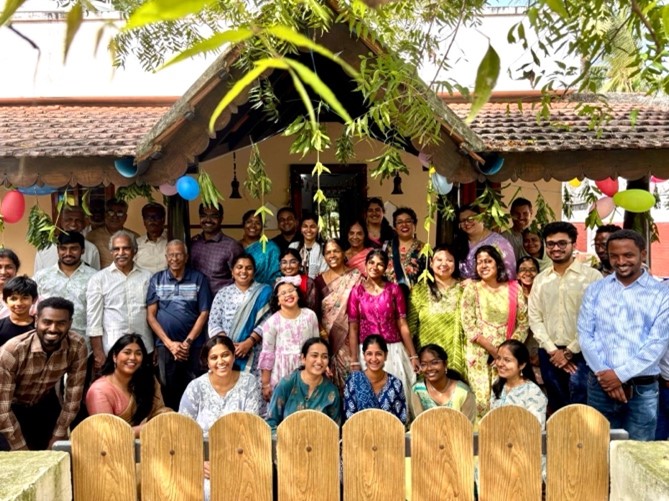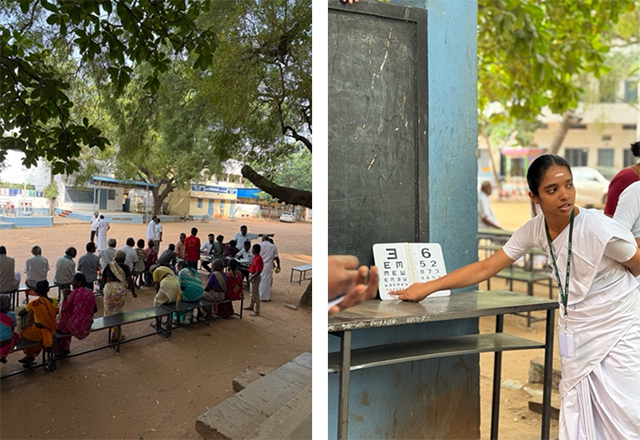
Guest Blogger Shruti Anant is a fourth-year medical student at Johns Hopkins from Northern Virginia. Her professional interests include using technology to address the burden of preventable blindness and in improving access to care for refugee populations. In her free time, she enjoys running, videography, film photography, and live music.
Infectious keratitis, or corneal ulceration, is an eye disease that is the fifth leading cause of blindness worldwide, causing two million cases of monocular blindness per year. Infectious keratitis presents as severe eye pain, redness and decreased vision, and can be caused by bacterial, fungal, parasitic or viral causes. Delayed presentation to the hospital remains a critical factor in severe cases of keratitis, especially for patients in resource-limited settings. Addressing patients’ barriers to accessing eye care is essential, because if left undiagnosed or untreated, infectious keratitis can progress rapidly to irreversible vision loss.
Global disparities exist in the incidence of infectious keratitis, and developing countries are disproportionately affected. In fact, the incidence of keratitis in South India is estimated to be over 10 times the incidence in the United States. Put simply, when patients, like many in India, are affected by a corneal ulcer that progresses without treatment, they can no longer provide for themselves or their families, losing their vision, their livelihood and much of their self-worth in the process.

While a Master of Public Health student at the Johns Hopkins Bloomberg School of Public Health, I had the opportunity to spend one month living and conducting research at Aravind Eye Hospital in Pondicherry, India. The purpose of my project was to survey patients presenting with keratitis to better understand the challenges they encountered accessing eye care. Our findings were compiled into a work report for the hospital. I also led the creation of a film on infectious keratitis, featuring patient and physician interviews, with the goals of increasing awareness and improving patient education. Both of our projects were undertaken with the idea that a better understanding of the social risk factors for keratitis can inform targeted public health interventions to improve access to timely, vision-preserving care for this patient population.

A deep dive into the work accomplished cannot be done without providing information about our international partner site, the Aravind Eye Care System, the largest and most productive eye care facility in the world. Aravind began as an 11-bed hospital in the town of Madurai, Tamil Nadu, India with one core mission: to eliminate avoidable blindness. Amazingly, most of Aravind’s patients receive care for free because the hospital operates on a pay-what-you-can model. Each of Aravind’s 12 hospitals in Tamil Nadu has a free section and a paying section. Patients decide where they will be treated, and the quality of treatment does not vary whether patients pay or not. Thus, the revenue from paying patients covers costs and generates revenue for the hospital in a productive, self-sustaining manner. In addition, Aravind runs free eye screening camps in surrounding villages, where patients who need surgery are transported to the base hospital for food, lodging, treatment and return travel, all free of charge.
In this way, the Aravind Eye Care system is a model for eye care across the world, and touring and working within this system truly changed my worldview on compassion, innovation and humanitarianism.

Our survey project was conducted at Aravind Eye Hospital in Pondicherry. We conducted over 20 in-person interviews and five video interviews with patients who currently had or who had been treated for infectious keratitis, all of them in their native Tamil language. Each of these interviews provided an opportunity to learn more about the life circumstances affecting Aravind’s patient population and the specific factors preventing them from accessing eye care.
As for insights gained from our surveys, most patients were not familiar with keratitis before being diagnosed at Aravind and had some form of trauma to the eye. Many had delayed seeking immediate care because they had not realized the severity of their injury or because they could not afford to miss work. Most patients had not completed any schooling. Most traveled over 20 kilometers (and some up to 100 km!) to attend their appointments. Many ultimately did not want to miss a day’s worth of wages, but the pain and fear of losing their vision convinced them to seek care at Aravind. Hearing and documenting each of these patient stories allowed for an opportunity to educate myself and connect with numerous patients on a personal level.

In addition to my direct project work, I had the chance to observe Aravind’s operations as leader in eye care. I visited a Vision Centre in Bhuvanagiri (a village outside of Pondicherry), where two nursing “sisters,” as they are fondly called at Aravind, were responsible for screening their entire village for eye-related issues, corresponding with physicians at the main hospital and referring patients for care.
After completing my project work in Pondicherry, I traveled by train to Madurai, where Aravind Eye was originally founded. Here, I had the chance to tour the grounds of the original hospital (which has greatly expanded since Aravind was founded) as well as Aurolab, Aravind’s surgical instrument and lens manufacturing facility, and visit an eye screening camp.

To attend an Aravind eye camp, I traveled with a team of two resident doctors, several nursing sisters and a few staff members at 6 a.m. on a Saturday to Usilampatti, a village an hour outside of Madurai. Here, in a schoolyard where camp was set up, I watched in awe as the team screened over 200 local patients (who had heard by word-of-mouth via a village announcement that camp was occurring) for eye-related issues and tested their vision.
About 30 of these patients needed urgent surgery (most of them for cataracts), and were transported back on a bus to the base hospital, where they received free surgical care, housing, food and a trip back home.
Outside of the hospital, I was lucky enough to visit South India during the Tamil harvest festival of Pongal. For the festival, I got to eat tasty pongal (a traditional dish in which rice is boiled in a clay pot with milk and mixed with clarified butter and sugar) and play uriyadi (in which players are blindfolded and try to break a clay pot hoisted in the air). It was lovely to experience the traditions, energy and culture of the city alongside my new friends and colleagues.

My time spent in India at Aravind Eye completing my M.P.H. field experience and practicum project was transformational. I learned how to conduct a global health project in a brand new environment, and could not have felt more welcomed by my colleagues at Aravind Eye. I witnessed firsthand how an ambitious idea with a clear and thoughtful mission can be scaled up to provide care to millions of people — and how much work there is still to be done to make eye care accessible and equitable. This experience will continue to inspire my future work in clinical practice and public health as an aspiring ophthalmologist. Thank you to my mentors and colleagues at the Wilmer Eye Institute, the Bloomberg School of Public Health and Aravind Eye Hospital for making this experience possible for me.

